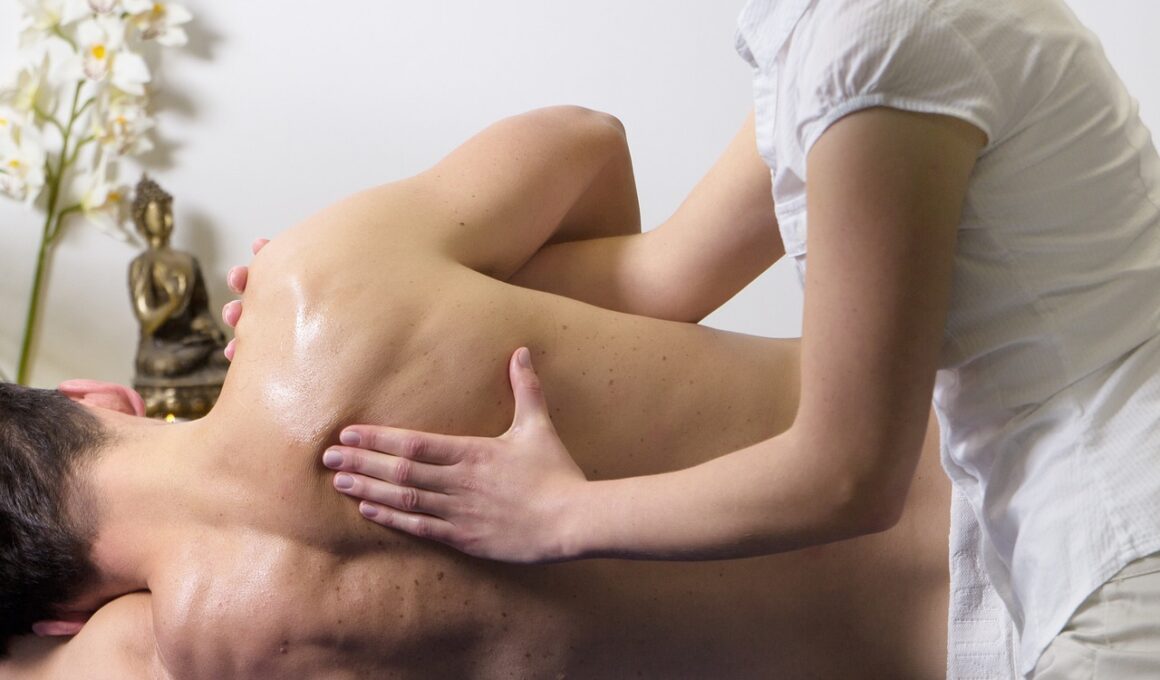Massage Therapy for Injury Prevention in Contact Sports
In contact sports, athletes face significant risks of injury due to the nature of the activities involved. These sports include football, hockey, rugby, and martial arts, where physical contact can lead to strains, sprains, and even more serious injuries. To mitigate these risks, athletes are increasingly turning to massage therapy as a preventive measure. Massage therapy not only helps in relaxing tight muscles but also improves blood circulation, aiding in quicker recovery. Regular sessions help in identifying potential problem areas before they develop into serious injuries. Apart from enhancing flexibility and range of motion, massage can help athletes maintain peak physical performance. Ensuring that the muscles remain pliable and free of tension allows for more extensive movements, which are often needed in contact sports. Additionally, therapeutic massage can ease muscle soreness and fatigue post-game, ensuring athletes are ready for subsequent activities. This is crucial to maximizing their performance while minimizing the risk of injury during high-stakes competitions. Overall, incorporating massage therapy into a training regimen can be a game-changer for athletes involved in high-impact sports.
In addition to physical benefits, massage therapy also plays a significant role in enhancing mental well-being for athletes engaged in contact sports. Stress and anxiety are common challenges in competitive environments, and these factors can lead to a decreased focus and impact performance. Utilizing massage therapy can induce relaxation, helping athletes mentally unwind. Techniques such as deep tissue massage or sports massage specifically target issues related to muscle tension while promoting overall tranquility. This mental clarity is especially important in contact sports, where split-second decisions can determine the outcome of a game. Furthermore, regular massage can foster a connection between the mind and body, reinforcing an athlete’s mental resilience. The ritual of visiting a massage therapist can serve as an essential part of an athlete’s self-care routine, allowing for a moment of reflection and rejuvenation amidst rigorous training schedules. This emphasizes the holistic approach to injury prevention that includes mental health considerations. When athletes feel good psychologically, they are less likely to succumb to injuries related to stress and can focus better on their techniques. Ultimately, the convergence of physical and mental health through massage is crucial for sustained athletic success.
Integration with Other Injury Prevention Strategies
Massage therapy should not be viewed in isolation when it comes to injury prevention strategies for athletes in contact sports. Instead, it should be considered part of a comprehensive training program that includes strength training, flexibility work, and proper nutrition. These elements work in conjunction to optimize overall athletic performance and reduce the risk of injury. For instance, strength training focuses on enhancing muscle endurance and joint stability, which are critical for withstanding the physical demands of contact sports. In addition, incorporating stretching and flexibility exercises can greatly improve an athlete’s balance and coordination. Massage complements these activities by addressing any tight muscles that can be a precursor to injury. When athletes develop a multi-faceted approach, they become more effective in reducing injury risks. Watching for signs of fatigue or pain becomes easier when athletes regularly engage in massage therapy, enabling prompt adjustments to their training regimes. Furthermore, consulting with healthcare professionals such as physiotherapists or trainers can provide additional insight tailored to each athlete’s specific needs. This collaboration fosters an environment aimed at achieving long-term health and performance goals.
Nutrition is another vital aspect that contributes significantly to injury prevention, which should be discussed alongside massage therapy. Proper nutrition fuels athletic performance and plays a critical role in recovery processes. Athletes require a balanced diet rich in proteins, carbohydrates, and essential fats to support muscle repair and recovery. Including foods high in antioxidants can help combat inflammation caused by rigorous training regimes. Techniques such as massage can assist muscle recovery post-training, but without the right nutritional support, the benefits may be limited. Hydration also plays a key role in sustaining optimal performance; muscle cramps and strains can occur when hydration levels drop. By pairing massage therapy with proper nutrition, athletes can create a comprehensive recovery plan that sets them up for success. Moreover, nutritional guidance can also help identify foods that promotes muscle strength, joint health, and overall energy levels. This integrated approach works effectively to fortify the athlete against injuries that may occur due to nutritional deficiencies. Consequently, there should be a concerted effort to educate athletes on the interplay between food consumption and massage therapy for maximum effectiveness.
Case Studies and Testimonials
The effectiveness of massage therapy in injury prevention is well-documented through various case studies and testimonials from athletes involved in contact sports. Many professional and amateur athletes alike have shared positive experiences regarding their incorporation of massage into their training routines. For instance, elite football players routinely include massage therapy as a primary component of their weekly schedules. Reports reveal significant reductions in muscle soreness and injuries when regular massage sessions are integrated. Athletes often describe feeling more balanced and less prone to strains and sprains after consistent therapeutic work. Additionally, many trainers have observed that their athletes maintain higher overall energy levels, enabling them to perform better during competitions. In another notable instance, a rugby team implemented a comprehensive massage protocol with their athletes and saw a marked decrease in injury reports throughout the season. This correlation between massage therapy and injury reduction highlights its necessity for teams and individual athletes. As sports science continues to evolve, these studies underlining the benefits of massage provide compelling evidence that this practice is essential for injury prevention. Testimonials further corroborate the positive impacts massage therapy can have on athletic performance.
In addition to professional testimonials, experiences from everyday athletes have also validated the role of massage therapy in preventing injuries during contact sports. Many recreational athletes articulate how regular therapy sessions have improved their ability to compete without experiencing frequent injuries that previously impaired their performance. This is especially important for individuals who partake in weekend leagues or amateur competitions, where injury risks can be higher due to varying skill levels and experience. Regular massage helps such athletes prepare their bodies for intense gameplay, allowing them to enjoy their sport without the looming fear of injury. Athletes often report faster recovery times and reduced muscle stiffness, ensuring they remain competitive throughout their seasons. Furthermore, some local sports teams have noticed a positive trend in performance after engaging massage therapists who specialize in sports-related injuries. These trends reflect the growing acceptance and recognition of massage as a vital component of athletic training. By prioritizing injury prevention strategies like massage therapy, athletes at all levels can enhance their enjoyment of contact sports while also minimizing downtime from injuries. Ultimately, the benefits of massage extend beyond competition, enriching the overall experience of participating in sports.
The Future of Massage Therapy in Sports
Looking toward the future, it is evident that the role of massage therapy in injury prevention for contact sports will only continue to grow. As more athletes and sporting organizations embrace holistic approaches to training, the inclusion of massage as an integral part of injury prevention strategies will become commonplace. Advances in technology and treatment techniques will likely provide further empirical support for the effectiveness of massage therapy. New research is continuously emerging, uncovering more about the physiological benefits that massage brings to athletes, deepen our understanding of muscle mechanics, and refine therapeutic techniques. Athletes can expect to benefit from collaborative efforts between massage therapists, physiotherapists, and trainers to tailor therapies that suit their unique needs. Furthermore, the emphasis on preventative health will continue as sports science keeps advancing, thus reducing the prevalence of injuries across various contact sports. Educational initiatives aimed at athletes, coaches, and teams regarding the importance of integrating massage therapy into their training routine will also play a vital role moving forward. As awareness increases, athletes can adopt best practices from the outset of their athletic careers.
In conclusion, massage therapy stands as an essential practice for injury prevention in contact sports. By combining physical relaxation with mental resilience, athletes position themselves for success while engaging in high-impact activities. The documented benefits of massage span a range of improvements—from enhanced flexibility to decreased injury risks. Strategies such as incorporating regular massage into training regimes, combined with proper nutrition and training techniques, create a well-rounded plan of attack against injuries. Research and testimonials support the importance of massage as part of a holistic athletic approach, emphasizing its relevance in injury prevention discussions. Moving forward, the relationship between massage therapy and sports performance will only become stronger. As athletes increasingly recognize and adopt massage therapy, they enhance their capabilities and extend their careers. With a focus on proactive injury prevention strategies, contact sports can provide athletes with the opportunity to thrive while keeping injuries at bay. The journey to optimal performance begins with effective recovery methods, and massage therapy is undoubtedly a pivotal component of that equation.


